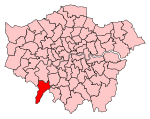Tolworth Court Farm Fields

Tolworth Court Farm Fields is a 43.3 hectare (107 acre) Local Nature Reserve (LNR) in Tolworth in the Royal Borough of Kingston, London. It was designated an LNR in 2004.The site has been farmed since Domesday Book in the eleventh century, and it was probably part of a high status manor in the Middle Ages. The hedgerows show signs of a ditch and bank next to them, and this together with ancient trees suggests that the hedges and layout of the fields pre-date the late eighteenth-century Enclosure Acts. The landscape has changed little in the last 150 years. The fields are currently managed as neutral hay meadows. The northern field is damp and has plants typical of periodically waterlogged fields, such as creeping bent and marsh foxtail. Mammals on the site include woodmice, field voles and roe deer. The wildlife has increased considerably over the years, it is regularly visited by little white egrets, herons love the water and the waterlogged field for frogs and lizards. There are several pairs of Kestrels, Sparrow hawks can be seen working the trees. A pair of Buzzards, Red Kites have been seen on a regular basis. A trip over the fields late in the evening will reward with several Tawny owls calling to each other, and numerous bats flying around. In 2017 a Jersey Tiger Moth was recorded resting on a bush. There is a very large array of Butterflies and moths. There is access from Kingston Road near Jubilee Way.
Excerpt from the Wikipedia article Tolworth Court Farm Fields (License: CC BY-SA 3.0, Authors, Images).Tolworth Court Farm Fields
Greenlands, Epsom and Ewell West Ewell
Geographical coordinates (GPS) Address Nearby Places Show on map
Geographical coordinates (GPS)
| Latitude | Longitude |
|---|---|
| N 51.371 ° | E -0.279 ° |
Address
Bonegate Open Space
Greenlands
KT19 9PS Epsom and Ewell, West Ewell
England, United Kingdom
Open on Google Maps









